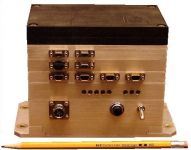U.S. Navy
Enhanced Smart Battery and Battery Management System (BMS)
Invocon has developed an enhanced smart battery and battery management system (BMS) design that uses novel sensing techniques to carefully monitor and control lithium batteries in order to maximize life and prevent thermal runaway.
Untethered Velocity of Sound Profiling Sensor (UVOSPS)

The U.S. Navy has awarded an SBIR Phase II contract to Invocon for UVOSPS (Un-tethered Velocity of Sound Profiling Sensor), a system to measure the water column sound velocity.
Wireless Airborne Instrumentation System (WAIS)
Invocon has developed two systems for the Navy directly related to aircraft health monitoring and evaluation.

The Wireless Airborne Instrumentation System (WAIS™) was developed for the Naval Air Warfare Center at the Patuxent River Naval Air Station in Maryland. The WAIS system replaces the wires between various test sensors and existing analog telemetry equipment on rotary and fixed wing aircraft.
This tightly synchronous, wireless link greatly reduces test preparation time and extends analog sensor placements on rotor hubs or other extreme locations.
Advanced Capability Initiative (ACI)

Invocon developed the Advanced Capabilities Initiative (ACI) system with Penn State Advanced Research Laboratory on a project sponsored by the Office of Naval Research. This system was designed to perform remote machinery diagnostics and prognostics on engine components or bearings.
Missile Defense Agency / Navy
Telemetry Data Acquisition System (TDAS)
Invocon developed the Telemetry Data Acquisition System (TDAS) to detect and locate impacts between defensive missiles and target missiles. TDAS offers a complete lethality assessment solution including hit grid, monitoring electronics, telemetry radio, and power source.
Kinetic Impact Position System (KIPS)
In order to more tightly integrate lethality assessment into target missiles, Invocon developed the Kinetic Impact Position System (KIPS). This system is smaller and faster than its predecessor, TDAS. This is accomplished, in part, by using vehicle power and telemetry. Additionally, KIPS incorporates Invocon’s patented Capture Link™ telemetry sharing technology that enables normal telemetry operation until impact. At this point, KIPS takes over the telemetry link to transmit lethality information.
Wireless Kinetic Impact Position System (WKIPS)
In order to further enhance its lethality assessment capabilities, Invocon developed the Wireless Kinetic Impact Position System (WKIPS). This system overcomes the need for heavy and error-prone hit grids by using the vehicle’s structure as part of the sensing agent during a hypervelocity impact. WKIPS can be used in a stand-alone mode or to augment a KIPS wired hit grid.
Target Missile Instrumentation
Invocon has supplemented its lethality assessment systems with several other instruments for monitoring and controlling target missiles. Some of this instrumentation includes
- Integrated PCM Encoder (iPCMe)
- Smart Rechargeable Batteries for general power as well as flight termination systems
- 7.5Ah
- 3.2Ah
- 0.74Ah
- Capacitive Discharge Initiator
- Multi-Channel Sequencer for event timing
U.S. Army
BodyLAN
Invocon co-developed BodyLAN, a multi-unit wireless system to measure pulse and breathing rates in humans. This system was designed as a proof-of-concept test for remote troop health monitoring in the field.
U.S. Air Force
Radiation Environment Monitor for Spacecraft (REMS)
The Air Force Research Laboratory has contracted with Invocon to develop a low-power miniature radiation spectrometer that can be mounted on spacecraft. The Radiation Environment Monitor for Spacecraft (REMS) will provide the capability to monitor radiation in order to enhance space weather models and aid in anomaly resolution for satellites.
Wireless Autonomous Telemetry System (WATS)

For the Air Force Air Armament Center, Invocon developed the Wireless Autonomous Telemetry System (WATS™). This synchronous, real-time, wireless data acquisition system was designed to aid in the flight-testing of aircraft.
